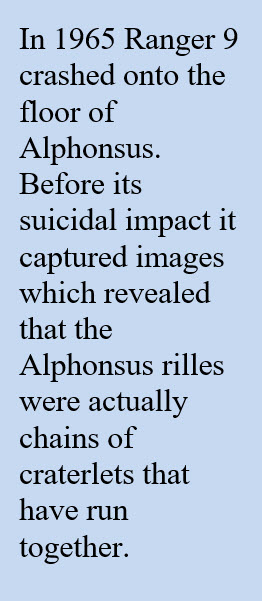The week of April 19-25 takes us from Lunar Day 7 to Day 14. This week we will highlight the crater Alphonsus, viewable on Monday night.

 Alphonsus: [SW/L9] Examine the adjoining rims of Ptolemaeus and Alphonsus. Which crater do you think appeared first?1 Alphonsus is one of the more interesting craters on the Moon. It not only has a central peak and a floor that displays rilles and small craters, some of the craterlets have enigmatic dark halos around them. These halos are the result of a little-known but fascinating volcanic activity called explosive pyroclastic eruptions. As magma is spewing out from volcanic vents, sometimes gases that are trapped within will suddenly expand and cause the molten rocks to explode in a shower of tiny dark glass beads. The result is that the area surrounding the source vent is covered by a dark halo of pyroclastic deposits. Alphonsus is the best place on the Moon for you to see the results of this phenomenon through backyard telescopes. Three of the most conspicuous halos are located close to the east rim and are connected by a thin rille.
Alphonsus: [SW/L9] Examine the adjoining rims of Ptolemaeus and Alphonsus. Which crater do you think appeared first?1 Alphonsus is one of the more interesting craters on the Moon. It not only has a central peak and a floor that displays rilles and small craters, some of the craterlets have enigmatic dark halos around them. These halos are the result of a little-known but fascinating volcanic activity called explosive pyroclastic eruptions. As magma is spewing out from volcanic vents, sometimes gases that are trapped within will suddenly expand and cause the molten rocks to explode in a shower of tiny dark glass beads. The result is that the area surrounding the source vent is covered by a dark halo of pyroclastic deposits. Alphonsus is the best place on the Moon for you to see the results of this phenomenon through backyard telescopes. Three of the most conspicuous halos are located close to the east rim and are connected by a thin rille.
Before you leave Alphonsus, notice how debris from the Imbrium impact has cut valleys completely through the southeastern rim! The low mountain ridge cutting through the center of Alphonsus is also thought to be ejecta from the Imbrium impact.
1 Can you see that the northern rim of Alphonsus intrudes slightly into Ptolemaeus, making Alphonsus the younger crater?
======================
It is highly recommended that you get a copy of Sky and Telescope’s Field Map of the Moon, the very finest Moon map available for use at the telescope. It is available for $10.95 at www.skyandtelescope.com and on Amazon. All features mentioned in this blog will be keyed to the grid on the Field Map and will look like this: Plato: [NW/D9]
Credits:
Courtesy of Gray Photography of Corpus Christi, Texas
Lunar photos: NASA / USGS / BMDO / LROC / ASU / DLR / LOLA / Moon Globe. Used by permission
- Rupes Cauchy: A Best Known Fault on the Moon - July 22, 2024
- Moon Crater Schickard – Crater Floor has Stripes - July 15, 2024
- Moon Craters Langrenus and Vandelinus - July 8, 2024